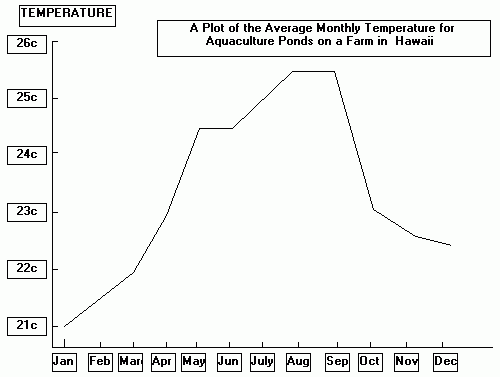
Temperature is a potent influence on the biological and chemical processes in any aquaculture system. In a subtropical area, seasonal temperature change potentially can influence the growth of tilapia. Additionally, if ponds are deep and water movement is lacking, thermal stratification may occur in deeper areas of the pond.
In tilapia culture tanks or ponds temperature should be measured and recorded daily. If thermal stratification is suspected, water specimens should be collected periodically from the deep areas and a temperature measurement obtained. (see the Information Module for a description of a collection method for bottom water samples).
Although each type of Tilapia has a different preferred temperature range, Tilapia in general are tolerant of temperature over an approximate range of 20'F (71'F to 91'F) or 10'C (22 to 33'C). If rearing temperature is within the low end of this range (e.g. < 77'F/25'C), exposed fish may display reduced growth rate and, possibly, increased susceptibility to infection. At higher temperatures (e.g. > 82'F/28'C), tilapia are more susceptible to low dissolved oxygen conditions.
If culture temperature is in the range of 61 to 70'F or 16 to 21'C, the exposed tilapia are likely to become infected, and will certainly display slow growth, and poor feed conversion.
If temperature is below 60'F/15'C or above 95'F/35'C mortality is likely.
Tilapia also need different temperatures over the course of thier life. For example: Mozambique Tilapia (Oreochromis mossambicus) appears to do best at 84'F when first born and then at 82'F during the fry stage, and grow to mature adult best between 78 and 82'F.
In colder areas, Tilapia will need to be grown in insulated tanks with heaters or inside a green house. In the San Diego area, Tilapia can be grown in 55 gallon food drums set on wood shipping pallets (or anything to insluate them from the ground), wrapped in a hot water heater insulating "blanket", and then placed in a low cost "temporary" greenhouse or tent during the winter months. A 300W tank heater may also be necessary during December. Solar water heating is also a possibility, especially a closed loop heat exchange system to prevent clogging, however copper tubing must never be used.

Questions:
See also:
| file: /Techref/other/pond/tilapia/temperature.htm, 3KB, , updated: 2018/10/18 05:27, local time: 2025/10/23 13:59,
216.73.216.53,10-2-207-162:LOG IN
|
| ©2025 These pages are served without commercial sponsorship. (No popup ads, etc...).Bandwidth abuse increases hosting cost forcing sponsorship or shutdown. This server aggressively defends against automated copying for any reason including offline viewing, duplication, etc... Please respect this requirement and DO NOT RIP THIS SITE. Questions? <A HREF="http://www.massmind.org/techref/other/pond/tilapia/temperature.htm"> Tilapia Topic, Aquaculture Environment, Temperature</A> |
| Did you find what you needed? |
Welcome to massmind.org! |
|
The Backwoods Guide to Computer Lingo |
.